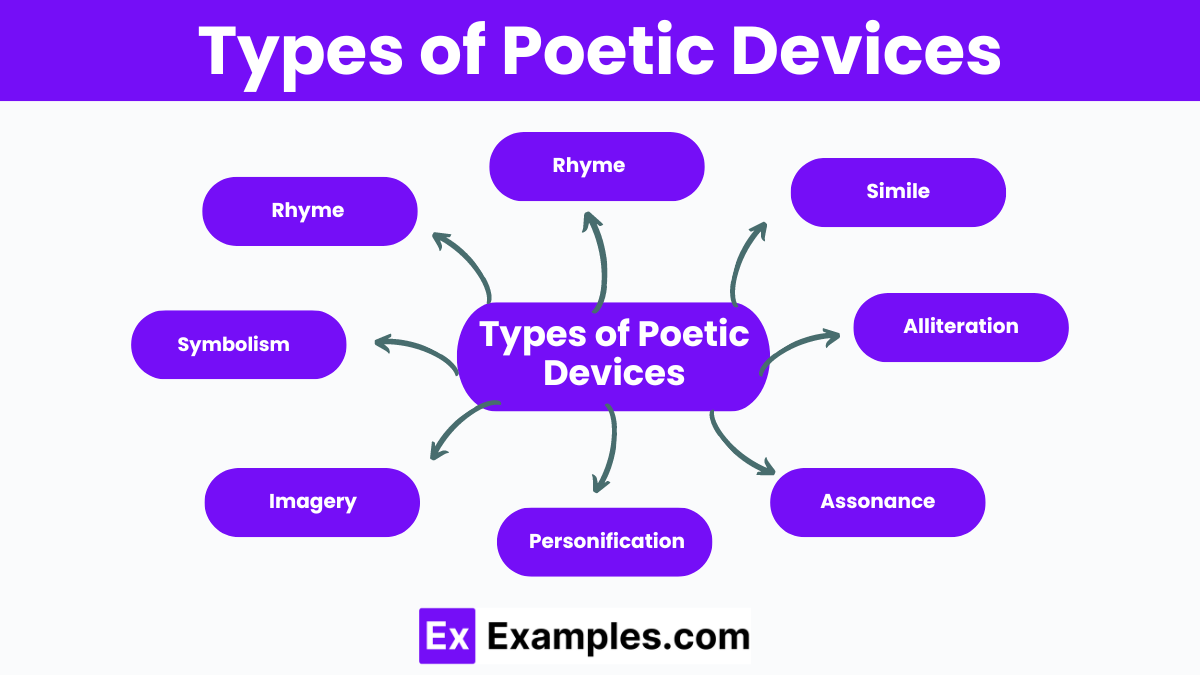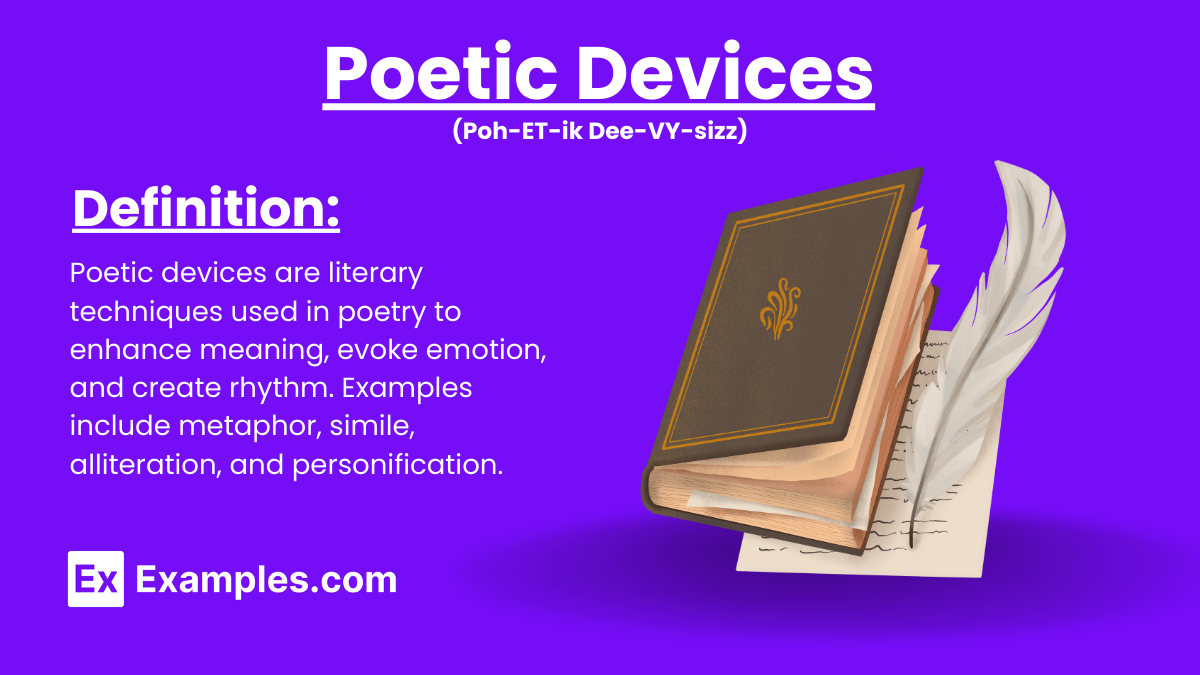18+ Poetic Devices Examples
Poetic devices are tools poets use to create rhythm, enhance meaning, and evoke emotions in their work. These techniques, such as assonance in poetry, involve the repetition of vowel sounds within a line or stanza, creating musicality and mood. Poets skillfully employ these devices to enrich their language, offering readers a deeper and more immersive experience. Understanding poetic devices helps to appreciate the nuances and artistry involved in crafting powerful poetry.
What are the Poetic Devices?
Poetic devices are techniques poets use to enhance their writing. These include metaphor, simile, alliteration, assonance, personification, imagery, symbolism, rhyme, and meter. These devices add depth, musicality, and emotional resonance, enriching the reader’s experience of the poem.
Poetic Devices with Examples
- “Life is a highway.”
- “As busy as a bee.”
- “She sells seashells by the seashore.”
- “The rain in Spain falls mainly on the plain.”
- “The wind whispered through the trees.”
- “A blanket of snow covered the field.”
- “A red rose symbolizes love.”
- “The cat sat on the mat.”
- “Shall I compare thee to a summer’s day?”
- “The bees buzzed busily.”
- “I’m so hungry I could eat a horse.”
- “A fire station burns down.”
- “The sun smiled down on us.”
- “The waves danced on the shore.”
- “He has a heart of stone.”
- “The sky weeps.”
- “The clock ticked loudly in the silent room.”
- “The light of the fire is a warm hug.”
- “Boom! The thunder roared.”
- “I have told you a million times.”
Types of Poetic Devices

- Metaphor – A direct comparison between two unrelated things, implying they are the same, enhancing understanding and imagery in metaphor poems for 4th grade.
- Simile – A comparison using “like” or “as” to create vivid imagery and highlight similarities between different things.
- Alliteration – Great alliteration is the repetition of initial consonant sounds in closely placed words, adding rhythm and musicality to the poem.
- Assonance – Assonance and consonance involve the repetition of vowel sounds within nearby words, creating internal rhyming and enhancing the poem’s musical quality..
- Personification – Attributing human characteristics to non-human entities, personification for Class 9 students makes these entities more relatable and vivid.
- Imagery – Descriptive language that appeals to the senses, creating vivid pictures and enhancing the reader’s experience.
- Symbolism – Using symbols to represent ideas or concepts, adding deeper meaning and layers to the poem.
- Rhyme – The repetition of similar sounding words, usually at the end of lines, creating rhythm and musicality.
- Meter – The structured rhythm of a poem, determined by the pattern of stressed and unstressed syllables.
Identifying Poetic Devices in Poems
- Read the Poem Thoroughly: Read the poem multiple times to grasp its overall meaning, tone, and initial impressions. Identify examples of assonance in literature to enhance your understanding.
- Identify Themes: Determine the main themes or messages the poet is conveying, which provide insight into the poem’s deeper meaning.
- Analyze Structure: Examine the poem’s form, stanza arrangement, line breaks, and overall layout to understand its structural choices.
- Look for Repetition: Identify repeated sounds, words, phrases, or lines that create rhythm and emphasize key points in the poem.
- Examine Word Choice: Pay attention to specific words the poet uses and how they contribute to the poem’s imagery and emotional impact.
- Identify Figurative Language: Look for metaphors, similes, personification, and other figures of speech that enhance the poem’s meaning.
- Consider Imagery: Observe descriptive language that appeals to the senses, painting vivid pictures and evoking strong emotions.
- Check for Rhyme and Meter: Analyze the patterns of rhyme and rhythm, noting how they contribute to the poem’s musicality and flow.
Poetic Devices: Punctuation
- Comma (,): Indicates a brief pause, separates ideas, and creates a rhythmic effect.
- Example: “The sun sets, the sky darkens, the stars appear.”
- Period (.): Marks the end of a thought, providing a sense of finality.
- Example: “The night is quiet. All is still.”
- Exclamation Point (!): Conveys strong emotion or emphasis.
- Example: “Oh, how beautiful the night sky is!”
- Question Mark (?): Poses a question, inviting reflection or uncertainty.
- Example: “Why do the stars shine so bright?”
- Colon (:): Introduces an explanation, list, or elaboration.
- Example: “The forest is alive: birds sing, leaves rustle, creatures stir.”
- Semicolon (;): Connects closely related independent clauses, balancing ideas.
- Example: “The wind whispers through the trees; the night listens in silence.”
- Dash (—): Creates a dramatic pause or adds emphasis.
- Example: “In the silence of the night—an owl hoots.”
- Ellipsis (…): Indicates an unfinished thought or trailing off.
- Example: “The stars shine on, silently watching…”
How Do Poetic Devices Work?
- Create Rhythm and Flow: Poetic devices like alliteration, assonance, and meter establish a musical quality, making the poem pleasing to read aloud and enhancing its overall flow.
- Enhance Meaning: Devices such as metaphors, similes, and symbolism add layers of meaning, allowing readers to find deeper interpretations and connections within the poem.
- Evoke Emotions: Imagery, personification, and hyperbole help paint vivid pictures and evoke strong emotions, making the poem resonate more with readers.
- Emphasize Ideas: Repetition, rhyme, and parallelism highlight key themes and ideas, making them more memorable and impactful.
- Engage the Reader: Irony, paradox, and enjambment create intrigue and surprise, engaging readers and encouraging them to think critically about the poem’s message.
Poetic Diction
- Elevated Language: Poets often use sophisticated and ornate language to give their work a formal or grandiose tone. This can include archaic words, elaborate phrases, and complex sentence structures.
- Figurative Language: Metaphors, similes, personification, and other figures of speech are central to poetic diction. They add depth and richness to the poem, allowing readers to see familiar things in new ways.
- Imagery: Descriptive language that appeals to the senses is crucial in poetry. Poets use vivid imagery to create strong mental pictures, evoking emotions and atmosphere.
- Sound Devices: Alliteration, assonance, consonance, and onomatopoeia contribute to the musical quality of the poem. These sound devices enhance the reader’s experience by creating rhythm and mood.
- Symbolism: Poets often use symbols to represent larger concepts or ideas. This allows them to communicate complex themes succinctly and powerfully.
- Economy of Language: Poetic diction is often concise, with each word chosen for its precise meaning and impact. Poets aim to express much in few words, using compact and potent language.
Rhyme Scheme in Poetic Devices
- Alternate Rhyme (ABAB)
- This rhyme scheme involves the first and third lines rhyming with each other, and the second and fourth lines rhyming with each other.
- Example:
The sun is shining bright (A) The sky is clear and blue (B) The birds are in flight (A) Singing tunes anew (B)
- Couplet (AA BB)
- In a couplet rhyme scheme, every two lines rhyme with each other.
- Example:
The rain fell all night long (A) It sang a soothing song (A) The flowers drank it in (B) Their beauty set to begin (B)
- Enclosed Rhyme (ABBA)
- This rhyme scheme features the first and fourth lines rhyming, and the second and third lines rhyming.
- Example:
The autumn leaves are falling (A) In colors rich and bright (B) They dance in the sunlight (B) The scene is quite enthralling (A)
- Terza Rima (ABA BCB CDC)
- Terza rima consists of interlocking three-line stanzas where the second line of each stanza rhymes with the first and third lines of the next stanza.
- Example:
The stars shine in the night (A) Their glow a guiding light (B) The moon is shining bright (A) As shadows softly fall (B) Night whispers to the trees (C) The world is still and tall (B)
- Monorhyme (AAAA)
- In a monorhyme scheme, all lines in the stanza or poem end with the same rhyme.
- Example:
The cat sat on the mat (A) It wore a little hat (A) Then it saw a rat (A) And gave a gentle pat (A)
Importance of Poetic Devices
- Enhances Emotional Impact – Poetic devices deepen emotional resonance, creating a stronger connection between the poem and the reader.
- Creates Rhythm – They establish rhythm, making the poem more engaging and memorable through patterns of sound and meter.
- Adds Musicality – Poetic devices add a musical quality to the poem, enhancing its auditory appeal when read aloud.
- Evokes Imagery – They help paint vivid pictures in the reader’s mind, bringing the poem’s scenes and emotions to life.
- Clarifies Meaning – Devices like metaphor and simile clarify abstract ideas, making complex themes more understandable.
- Establishes Tone – Poetic devices set the tone, conveying the poet’s attitude and mood effectively.
- Provides Structure – They offer structural frameworks, helping to organize thoughts and create a cohesive flow in the poem.
- Engages the Reader – By making the text more interesting and dynamic, poetic devices keep the reader’s attention and encourage deeper engagement.
How is a simile different from a metaphor?
A simile compares two things using “like” or “as.”
What is alliteration?
Alliteration is the repetition of initial consonant sounds in nearby words.
What is onomatopoeia?
Onomatopoeia is a word that imitates the natural sound of a thing.
How does imagery enhance a poem?
Imagery creates vivid pictures in the reader’s mind through descriptive language.
What is the purpose of a rhyme scheme?
A rhyme scheme gives a poem structure and rhythm.
What is personification in poetry?
Personification gives human characteristics to non-human objects or abstract ideas.
What is hyperbole?
Hyperbole is an exaggerated statement used for emphasis or effect.
What is the effect of using enjambment?
Enjambment allows a thought to continue beyond the end of a line for added flow and surprise.
What is the role of repetition in poetry?
Repetition emphasizes important ideas and creates rhythm.



